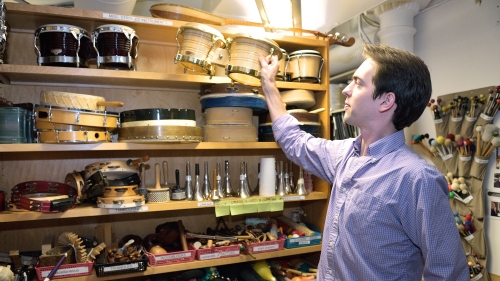For students in NYU Steinhardt’s Music Therapy program, music is more than just an artistic pastime, but a powerful tool in the service of human wellbeing.
“We really think of music as a health resource,” said Kenneth Aigen, director of music therapy. “It enhances your quality of life. Music therapy is about providing the intrinsic health benefits of music to people who can’t access them on their own, even as it also provides clinical benefits on nonmusical things like speech, social-emotional health, physical coordination, and more.”
A premier feature of the Music Therapy program is its emphasis on clinical musicianship, with students taking classes in piano, guitar, and voice in order to learn the specific musical skills necessary for effective therapy.

“It isn’t enough to have a musical background,” Aigen explained. “A key part of clinical musicianship is being able to use music to create an experiential world around the client, and to do that you really need to understand your instrument as a tool of dialogue and communication. Our students learn how to improvise with clients, reading cues that may not always be overt and responding to them musically.”
Students are placed in a clinical setting from day one, from child-centered sites in their first semester to nearly 30 hours a week of clinical experience at adult sites – which may include hospitals, prisons, and elderly care centers – by the time they identify a specialty in their second year.
Throughout their time at NYU Steinhardt, students are immersed in a community of practitioners with a strong sense of care and investment in their work. This is especially critical in the world of music therapy, which can be emotionally strenuous and physically taxing.

“We are not just an educational program, but a community that believes very deeply in the power of music. This is a community of care, and the relationship between students and faculty in the program is a template for the relationship between therapists and clients at a clinical site. We want to create an educational relationship that is a model for how music can be a force for community building,” said Aigen.
To that end, a key part of the Music Therapy program is participation in training groups, therapeutic educational spaces in which students participate in music therapy from the client side. In these, they gain firsthand experience of the benefits and challenges of music therapy for clients, while also accessing a supportive space to work through their own thoughts, fears, and challenges – and bettering their own therapeutic practice.
“If you look at music therapy as a field, you see a lot of boundaries dissolving as people begin to see that there is a real clinical and human benefit to music, and it’s possible to combine art and education and health in a way that’s really vital to the wellbeing of the person,” said Aigen. “In that way, Music Therapy is emblematic of the work that is going on across NYU Steinhardt – here, we can look at something that is very complex and has a lot of creative tensions and see that as a resource rather than a problem. Steinhardt is a nexus and a lab for how really different ideas can work together with synergy.”
